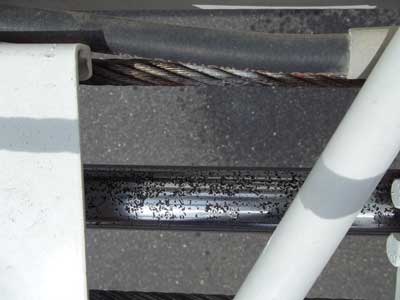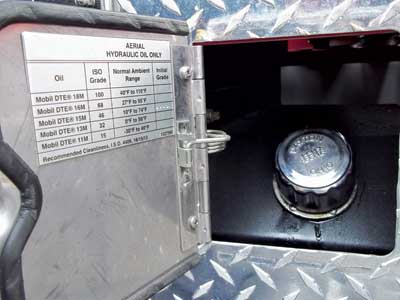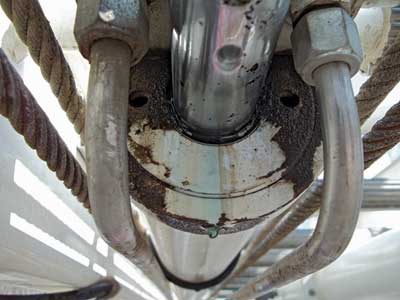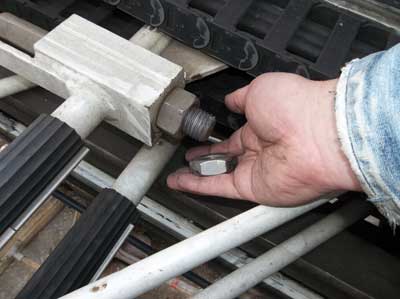<Previous Displaying 2/2 Page 1, 2
View Article as Single page
Hydraulic Fluid
Proper testing of hydraulic fluid, often required annually, requires a laboratory and is outside the scope of what is expected of a company-level inspection program. As part of your program, you are essentially interested in ensuring the fluid is at the proper level and is not coming out of anywhere. Maintaining the fluid level is crucial to proper aerial performance because not only does the fluid move and lift the aerial, but it is also the mechanism by which the hydraulic system cools itself. Often, firefighters are not fully aware that the hydraulic fluid heats up under pressure and that when it is returned back to the reservoir tank, the tank volume allows it to cool before the fluid is pumped back under pressure into the cylinders and pistons. Hence, maintaining the proper fluid level is key to not only aerial function and performance but also to overall longevity.
The hydraulic reservoir capacity can range from 40 to 100 gallons, depending on many factors. Unless otherwise noted, check the reservoir when the aerial and outrigger system is fully stowed in the road travel position and the fluid is cold. Typically, then this item would actually be the first step in a company inspection even prior to pulling the apparatus outside. Through its closed system design, the hydraulic system does not tolerate contaminants or air entrained in the fluid.
Although large air pockets would be fairly obvious and recognizable during hydraulic operations, you may not notice when the reservoir runs even slightly below capacity and the hydraulic pump cavitates, entraining air into the fluid. This can lead to foaming, which not only impairs hydraulic system performance and diminishes load-bearing ability but also can cause severe damage to the hydraulic cylinders and other components.
This damage is indicated by pitting of the cylinder piston rods and is often mistaken as simple corrosion caused by water in the hydraulic system (photos 8-9). It is certainly true that water corrodes metal parts; in this case, the visible damage is small divots in the metal surfaces that occur when the hydraulic fluid is compressed in the cylinder body and the microscopic entrained air molecules rupture or “explode.” When these explosions occur against the metal cylinder body or piston surfaces, they create divots in the polished surfaces, which impair capacity and holding performance, often accompanied by fluid loss (external leaks). Although surface corrosion can be often wiped away, leaving no damage, these divots are true holes and can be felt by rubbing with a fingernail.


Repairing this damage is expensive and time consuming. You can easily prevent this through proper hydraulic fluid reservoir level maintenance checks. Checking the fluid level also includes maintaining an on-hand supply of clean appropriate hydraulic fluid. Hydraulic fluids are generally not interchangeable, and to the greatest extent possible you should add the same brand/type of fluid to the reservoir.
Posting clear labels or placards at the fill point and on the containers can assist members in making the right choice of what fluid goes where into the vehicle. This is paramount on apparatus with other “hydraulic” systems such as hydraulic generators and rescue tools. Labeling a container as just “hydraulic fluid” or “truck hydraulic” can result in adding the wrong hydraulic fluid to the wrong system, resulting in an equally expensive and time-consuming repair. Be specific, and use permanent paint or markers to label containers in an unmistakable manner such as “Truck 5–Aerial Hydraulic Oil.” The brand/type of oil should remain visible on the container, and a similar label should be posted at or near the fill cap reflecting “Use Only Type X Hydraulic Oil” (photo 10).

When performing a visual inspection, note any fluid loss that meets the definition of a “leak.” Leaks are considered losses of fluid that are dripping or forming drops and do not necessarily mean that a film or spot has formed on a component (photo 11). Address any point of loss that is actively dripping or forming drops in a timely manner. Hydraulic systems are susceptible to particle contamination-anywhere that fluid is leaking is a possible point of entry for dirt, minerals, and other contaminants. Keep fill caps and tank plugs tight, and replace any missing or worn sealing gaskets. Rags stuffed in ports or leaking caps are all prime routes for contamination that must be resolved quickly.

Good Washing Practices
Aside from looking good and showing organizational pride, a clean apparatus serves to improve overall longevity. Don’t forget these finer points as part of aerial apparatus washing:
- Do not use pressure washers on aerial components. It may be acceptable to use pressure washers on wheel wells or undercarriages, but pressure washing the aerial can drive dirt and grime into the rails and cables. The pressure streams can drive dirt and grime deep into lubricating greases, turning them into abrasives, Conversely, the pressure can force grease out of wear and contact surfaces, leaving them devoid of any lubrication.
- Periodically wash the apparatus with the outriggers deployed. While stowed, the stabilizer system can accumulate road grime and salt residues that destroy paint and corrode metals. Don’t overlook the jack feet and lower components that hang exposed during road travel. In areas where road salt and liquid deicing sprays are used, the road splash can deposit on outrigger components and slowly eat its way through protective finishes and metals. Similar conditions can occur when apparatus is subjected to salt spray from waterfront areas and during flood recovery. Deploy the outrigger systems, and wash the painted surfaces thoroughly with mild detergents and rinse well. After drying, inspect sliding and moving surfaces for loss of lubrication, and reapply as necessary.
- Pay attention to the soaping and sponging work. As you wash the various components, don’t overlook this opportunity to visually inspect the apparatus for possible damage. It would be rather tedious to have to run your hands all over the apparatus just to look for damage, so use your time effectively and combine washing with an overall visual inspection. Developing problems such as loose fasteners, damaged wiring, and fluid leaks can often be identified and corrected long before serious and expensive repairs and downtime become necessary (photo 12). Are you short on time and personnel to thoroughly wash the complete aerial apparatus? Divide the work into parts, and alternate on different shifts or weeks. One crew washes/inspects the aerial ladder and related structures while the other crew washes/inspects the chassis and body.

Training and familiarization with your aerial apparatus are key components of safe fireground operations. Provide regular operator refresher opportunities. While you are out on area familiarization or in-service inspections, practice aerial positioning and deployment with “live” targets instead of in the firehouse parking lot.
As part of larger training exercises in which the aerial is operated and deployed for an extended period, do not lose sight of the fact that nonemergency aerial operation is still aerial usage; it is good practice to visually inspect the aerial after prolonged use for proper lubrication and overall condition.
This information is intended to increase the general knowledge of operations personnel and better tune them into their aerial. Many repairs that cause downtime and expense manifest themselves early as small and subtle clues that depend on the ability of company personnel to detect and recognize. If you can perform these simple actions regularly, then you have already taken great steps to improve your aerial operations. Apparatus longevity and future fireground safety depend on implementing a good aerial inspection, testing, and maintenance program.
David T. Phelan, CFPS, CFEI, is a 22-year veteran and the safety officer of the Bergenfield (NJ) Fire Department. He is a certified fire officer I, fire protection specialist, and fire investigator. Phelan leads the aerial fire apparatus division at a fire apparatus inspection and testing firm.
Additional Links
AERIAL OPERATIONS FOR LOW-RISE BUILDINGS
Safe and Effective Aerial Ladder Operations
<Previous Displaying 2/2 Page 1, 2
View Article as Single page
Fire Engineering Archives

